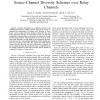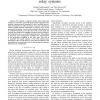110
Voted
WCNC
2008
IEEE
15 years 7 months ago
2008
IEEE
—We present link-diversity routing, a routing paradigm that achieves high path resilience in mobile ad hoc networks. Link-diversity routing chooses each hop of a packet’s route...
WCNC
2008
IEEE
15 years 7 months ago
2008
IEEE
Abstract— The inter-modulation and cross-modulation products of interferences introduced by nonlinearities of the receiver could significantly degrade system performance, and sh...
WCNC
2008
IEEE
15 years 7 months ago
2008
IEEE
— In an opportunistic spectrum sharing system, secondary users equipped with cognitive radios opportunistically access spectrum that is not being used by the primary users, i.e.,...
112
click to vote
WCNC
2008
IEEE
15 years 7 months ago
2008
IEEE
— Diversity techniques are an effective answer to the challenges presented by fading channels. This paper focuses on studying the performance of systems with diversity of three f...
WCNC
2008
IEEE
15 years 7 months ago
2008
IEEE
—In this paper, we present a reliable real-time data delivery (communication) mechanism for ad-hoc networks, called RTRD. The mechanism makes use of a proactive wireless routing ...
WCNC
2008
IEEE
15 years 7 months ago
2008
IEEE
In this paper we propose the one4all cooperative access strategy to introduce a more ef cient media access strategy for wireless networks. The one4all scheme is designed for the ...
99
Voted
WCNC
2008
IEEE
15 years 7 months ago
2008
IEEE
—UWB technology can reach centimetre level ranging and positioning accuracy in LOS propagation when time of arrival techniques are used. However, in a real positioning system, th...
WCNC
2008
IEEE
15 years 7 months ago
2008
IEEE
— We consider a cognitive wireless relay system that operates on secondary spectrum sharing basis using spectrum pooling. A spectrum pool comprises of a set of available narrowba...
WCNC
2008
IEEE
15 years 7 months ago
2008
IEEE
—This paper proposes the use of group-orthogonal frequency diversity combined with space-time block coding (STBC) to improve the performance of IEEE 802.11n wireless networks (WL...
124
Voted
WCNC
2008
IEEE
15 years 7 months ago
2008
IEEE
— We propose a new multiple description (MD) coder design based on the Adaptive Multi-Rate Wideband (AMRWB) coder that can support transcoding-free communication between an ad-ho...


